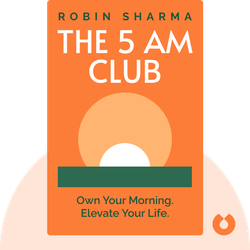Try Blinkist to get the key ideas from 7,000+ bestselling nonfiction titles and podcasts. Listen or read in just 15 minutes.
Start your free trial
Blink 3 of 8 - The 5 AM Club
by Robin Sharma

An In-depth Exploration of Essential Concepts and Processes from Around the World
The Art of Fermentation by Sandor Ellix Katz is an in-depth guide to the art and science of fermentation. From kimchi to kefir, this book explores the history, health benefits and techniques of fermentation, providing invaluable insight for beginners and experts alike.
Fermentation. It’s a word you've probably heard, and if you’ve ever eaten bread or cheese or drunk beer, you're familiar with the products of this vital process. But what does fermentation actually mean? To answer that question, we need to go all the way back to the origins of life on our planet.
All of Earth’s life forms need energy for their cells to create macromolecules, their building blocks. The way a cell obtains this energy is through its metabolism. The very first living organisms, certain kinds of bacteria, had anaerobic metabolisms – that is, they didn’t need oxygen to convert nutrients into energy. Another word for this process? Fermentation.
As time went on, new kinds of metabolism would develop from these fermenting bacteria, leading to life on Earth as we know it today.
The key message in this blink is: Fermentation transformed our planet.
As biologists Lynn Margulis and Dorion Sagan put it in their study of microbial evolution, Microcosmos, bacteria actually invented all of life’s essential chemical systems.
Take our oxygen-rich atmosphere – the precondition for the existence of complex life-forms like animals, plants, and fungi. This was created by fermenting bacteria.
How did they do it? Well, during the first couple of billion years of life on Earth, these bacteria interacted with one another. It could be a struggle to the death, with one bacterium destroying another. But it could also be a complex, two-way relationship that transformed both bacteria. One product of this second type of interaction was a new kind of metabolism.
Over time, certain microbes evolved to produce, or photosynthesize, energy from sunlight. The byproduct of this nutritional strategy was oxygen. As the number of these microbes grew, the planet’s atmosphere was oxygenated – and transformed forever.
At this point, the first aerobic – or oxygen-dependent – cells entered the evolutionary fray. It appears that their relationship with older, anaerobic cells was initially that of predator and prey. Over time, though, these former foes learned to coexist. Aerobic cells took up residence inside anaerobic cells without destroying them – an arrangement that allowed both parties to profit from each other’s metabolisms.
It was this relationship that paved the way for the emergence of eukaryotes – the complex organisms which, at a cellular level, make up the building blocks of all human, animal, and plant life.



The Art of Fermentation (2012) is an award-winning exploration of fermentation – a biological process that offers a key to understanding our species’ evolution and culture. From the emergence of life on Earth to alcohol-loving bats and the art of making sauerkraut, Sandor Katz leaves no stone unturned in this gripping account of the natural and human history of fermentation.
The Art of Fermentation (2012) is an informative and captivating book that explores the art and science behind the fermentation process. Here’s why it’s worth reading:
If we are to enjoy surpluses of food, then we must have strategies for preserving them in the presence of our microbial ecology.

It's highly addictive to get core insights on personally relevant topics without repetition or triviality. Added to that the apps ability to suggest kindred interests opens up a foundation of knowledge.
Great app. Good selection of book summaries you can read or listen to while commuting. Instead of scrolling through your social media news feed, this is a much better way to spend your spare time in my opinion.
Life changing. The concept of being able to grasp a book's main point in such a short time truly opens multiple opportunities to grow every area of your life at a faster rate.
Great app. Addicting. Perfect for wait times, morning coffee, evening before bed. Extremely well written, thorough, easy to use.
Try Blinkist to get the key ideas from 7,000+ bestselling nonfiction titles and podcasts. Listen or read in just 15 minutes.
Start your free trial
Blink 3 of 8 - The 5 AM Club
by Robin Sharma
What is the main message of The Art of Fermentation?
The main message of The Art of Fermentation is the transformative power of fermentation for food preservation and flavor enhancement.
How long does it take to read The Art of Fermentation?
The reading time for The Art of Fermentation varies, but it typically takes several hours. The Blinkist summary can be read in just 15 minutes.
Is The Art of Fermentation a good book? Is it worth reading?
The Art of Fermentation is worth reading for anyone interested in fermentation. It provides valuable insights and practical techniques for home fermenters.
Who is the author of The Art of Fermentation?
The author of The Art of Fermentation is Sandor Ellix Katz.